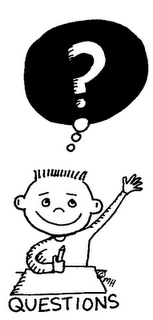What I Need to Know About Questions to be an Affective Teacher
From reading these articles I have learned several ways to go about asking questions and answering them as a teacher. By reading the article The Right Way to Ask a Question, I have found that even though you are a teacher, that does not mean that you know every answer to every question. As I teach through lectures it is very important for me to constantly ask my students if they understand the material, and if they have any questions. I need to let my students know that I am there if they should need any additional help ,or if they simply don't understand the lesson. This article also states there there are many different types of children in the classroom such as: the smart kids, the kids who don't want to learn, and the kids who really don't care. It's important for me to call on different students by name to wake their minds up and get the other kid's brains thinking also. When using this procedure, it is important to call on the children randomly. That being said, there will be a higher chance that the child is paying attention during the lecture.
The second article I read was, Asking Questions to Improve Learning. This article was a little different from the previous one. It was set up in bullet format and was very easy to understand. I learned that as a teacher, I should keep my course goals in mind when asking questions, and to put notes in my lesson plans to show me when I will ask a question. Also, to keep my questions clear and to the point for my students. Follow up questions are also very effective for students. I should use "closed questions" that only have one answer on tests, and "open questions" with lots of answers during class time. When responding to students answers, I should stay positive and never interrupt the student. It is important for the child that I always act like I am interested in what they are saying by nodding, and using expressions. This article has provided me with lots of useful information I can use as a teacher.
In the article Three Ways to Ask Better Questions in the Classroom, it gives three very important points. The first is to prepare questions for students. When making lesson plans it's a good habit to insert questions you will ask during a lecture. If you are not organized, and forget what questions you want to ask, then the questions might become unclear. The next point is to play with questions. This means that after asking a question, let the students minds think for awhile. You could wait until the end of class to answer the question, or even the next class time. The goal is to make students think before just providing them with the answer. The final point is to preserve good questions. This means that the best questions should be kept in your notes and lesson plans as something to always go to. You could even use a student's question that you liked. You could then announce in class before asking the question, that a student from your previous class is the one who came up with it. This article is very beneficial and tells us that asking good questions helps students think ,and also learn better.
Asking Better Questions in the Classroom is a youtube video that talks about the difference in open ended and closed ended questions. Open ended questions are questions that only allow students to answer with yes or no. These kinds of questions don't get students brains thinking because they don't require a response that is thoughtful. When answering these questions, students don't think about the answer, they just respond with whatever pops into their head. Open ended questions require the students to think. These question require a thoughtful response that needs to be thought out before answering. Open ended questions are more effective than closed ended questions because of the thought process they require.
The next video Questioning Styles and Strategies, was my favorite so far. I enjoyed watching the teacher ask questions and the students answer them. The teacher was able to ask questions very effectively and the students responded very well. Many different techniques were used in this video such as provisional writing and queuing. This allowed the students to write down their answer as they listened to the teacher's question. The teacher used random calling when asking questions during the class, and also allowed student calling, which is when a student calls on another student. The teacher extends his questions off of other students answers, which is great. There are lots of wonderful techniques in this video that have the potential to be great in a classroom.
Overall, these videos have really opened my understanding to what kinds of questions are good to ask ,and which ones are not so good. I have learned many different methods to use such as open ended and closed ended questions. I too have learned to stay positive when answering questions and providing feedback to students. I believe I will be able to use lots of these methods, if not all of them in my future classroom.

No comments:
Post a Comment